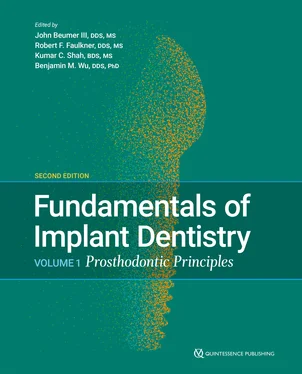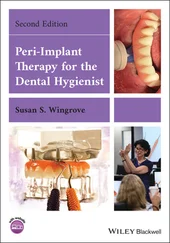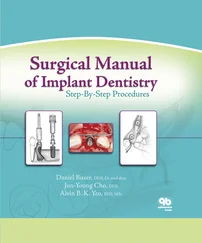Chemical substances commonly used for implant surface decontamination have been shown to increase the implant surface roughness and release degradation particles, which may stimulate inflammatory responses in the peri-implant tissues. 118, 135
One profound mechanical technique to debride the implant surface is implantoplasty , or mechanical removal of implant threads in an attempt to decrease the surface roughness and make the implant surface less retentive of biofilm. The procedure is carried out using diamond burs under copious irrigation with sterile saline and stones to polish the implant surface. 136As a result, however, particles and debris from implant surfaces are released into the surrounding tissues despite abundant irrigation to remove debris during and after implantoplasty. In addition, implantoplasty modifies the implant design, causing more stress at the damaged area of the implant surface and surrounding bone.
Titanium brushes have been introduced for mechanical debridement and decontamination of the implant surface. 137, 138Although the presence of titanium-based particles following the use of titanium brushes has not been evaluated, it has been suggested that the use of titanium brushes is less damaging to the implant surface compared with diamond burs used for implantoplasty. Similarly, the use of ultrasonic scalers to remove the biofilm from the implant surface can cause surface deterioration. This is observed both with metallic and plastic ultrasonic tips, which also generate titanium particulate that can be identified in rinsing solutions. 139
In a histologic investigation of 36 peri-implantitis biopsies in humans treated with implantoplasty, foreign bodies—mostly titanium particles—were formed, and these were surrounded by chronic inflammatory infiltrates. 140Other histologic studies 123, 139have confirmed the presence of micro- and nanoparticles in subepithelial connective tissues following implantoplasty. The histologic analysis showed areas of chronic inflammation with lymphocytes and plasma cells, which may suggest negative effects of titanium particles in the surrounding peri-implant tissues. Titanium particles may affect the expression of RANKL and osteoprotegerin (OPG) in osteoblastic cells and activate osteoclasts and pathologic bone remodeling. 126A synergistic effect of the presence of released titanium ions with Porphyromonas gingivalis can increase the expression of cytokine ligand 2 (CCL2), RANKL, and OPG in peri-implant tissues. 126It has been suggested that titanium ions at concentrations of 13 ppm may cause epithelial cell necrosis, but the biologic mechanism is not fully understood. 141, 142Pettersson et al 143suggested that titanium particles rather than titanium ions stimulate the inflammatory response, with recent data suggesting that titanium nanoparticles have genotoxic and cytotoxic potential. 144– 146
The cytotoxicity has been further investigated in orthopedics and showed that particle release from prosthetic joints can be detrimental to cells and body tissues, resulting in aseptic loosening of the implant. 122Nevertheless, the content of particles needed to cause cytotoxicity is still not clear. In addition, systemic accumulation of titanium micro- and nanoparticles has also been reported in the lymph nodes, lungs, liver, and spleen. 125, 147
Summary
Significant advances have been made during the last 20 years to increase the bioactivity of implant surfaces. The initial efforts (titanium plasma spray surfaces, HA-coated surfaces, the original acid-etched surfaces) to improve the clinical performance of titanium dental implants had significant disadvantages. In the early 1990s, several methods (double acid etching, anodic oxidation, titanium grit blasting, sandblasting/acid etching) were developed to create microrough surface topographies on titanium implants. These surfaces were shown to dramatically improve clinical performance, particularly in poor-quality bone sites. More recently, methods have been developed to improve clinical performance by increasing or maintaining the wettability of the implant surfaces and facilitating osteoconductivity by creating biomimetic nanoenhanced implant surfaces.
Titanium materials have long been considered to be bioinert. Therefore, it has been believed that the presence of a titanium implant in an osteotomy site should not influence the wound healing process. While the mechanistic elucidation is not complete, it is increasingly clear that osseointegration is not achieved only via bone formation. Recent observations and experimental evaluations indicate that there are distinct molecular and cellular behaviors that appear to be unique to peri-implant tissue. Some of these characteristics contribute to the mechanical advantage and long-term stability of osseointegrated implants. In addition, peri-implant bone may not undergo the same biologic and pathologic sequences as tooth-bearing alveolar bone.
After manufacturing and before surgical placement, implant surfaces age, during which hydrocarbons accumulate, hydrophilicity is lost, and the electropositive surface changes to electronegative and impairs the osteoconductivity of implant surfaces. Photofunctionalization is one method to recondition the implant surface by removing hydrocarbons from the implant surface, restoring hydrophilicity and improving electrostatic charge.
After surgical placement, the degradation of implant surfaces in the presence of peri-implant diseases and the release of titanium particles during and after management of peri-implantitis are still of concern. Further studies are required to evaluate the local and systemic effects of those particles and propose guidelines for prevention, management, and maintenance of peri-implant diseases.
References
1.Ogawa T, Nishimura I. Genes differentially expressed in titanium implant healing. J Dent Res 2006;85:566–570.
2.Ogawa T, Nishimura I. Different bone integration profiles of turned and acid-etched implants associated with modulated expression of extracellular matrix genes. Int J Oral Maxillofac Implants 2003;18:200–210.
3.Wilson CJ, Clegg RE, Leavesley DI, Pearcy MJ. Mediation of biomaterial- cell interactions by adsorbed proteins: A review. Tissue Eng 2005;11(1–2):1–18.
4.Noh H, Vogler EA. Volumetric interpretation of protein adsorption: Competition from mixtures and the Vroman effect. Biomaterials 2007;28:405–422.
5.Vroman L. Effect of adsorbed proteins on the wettability of hydrophilic and hydrophobic solids. Nature 1962;196:476–477.
6.Ruggeri ZM. Mechanisms initiating platelet thrombus formation. Thromb Haemost 1997;78:611–616.
7.Steinberg AD, Willey R, Drummond JL. In-vivo comparisons of clot formation on titanium and hydroxyapatite-coated titanium. J Periodontol 1992;63:990–994.
8.Hong J, Andersson J, Ekdahl KN, et al. Titanium is a highly thrombogenic biomaterial: Possible implications for osteogenesis. Thromb Haemost 1999;82:58–64.
9.Albrektsson T, Hansson HA. An ultrastructural characterization of the interface between bone and sputtered titanium or stainless steel surfaces. Biomaterials 1986;7:201–205.
10.Park JY, Gemmell CH, Davies JE. Platelet interactions with titanium: Modulation of platelet activity by surface topography. Biomaterials 2001;22:2671–2682.
11.Thor A, Rasmusson L, Wennerberg A, et al. The role of whole blood in thrombin generation in contact with various titanium surfaces. Biomaterials 2007;28:966–974.
12.Kämmerer PW, Gabriel M, Al-Nawas B, Scholz T, Kirchmaier CM, Klein MO. Early implant healing: Promotion of platelet activation and cytokine release by topographical, chemical and biomimetical titanium surface modifications in vitro. Clin Oral Implants Res 2012;23:504–510.
13.Yang Y, Lai Y, Zhang Q, et al. A novel electrochemical strategy for improving blood compatibility of titanium-based biomaterials. Colloids Surf B Biointerfaces 2010;79:309–313.
Читать дальше












